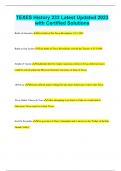Samenvatting
Detailed Summary Drug Targets Biochemistry and Signaling
Made this summary for DRUG TARGETS BIOCHEMISTRY AND SIGNALING. Summary is detailed and complete. However, chapter 11 and 12 were not saved correctly. These are lost. I had a printed backup which is scanned and included in this summary. The quality is the same as the rest of the summary. The only ...
[Meer zien]














